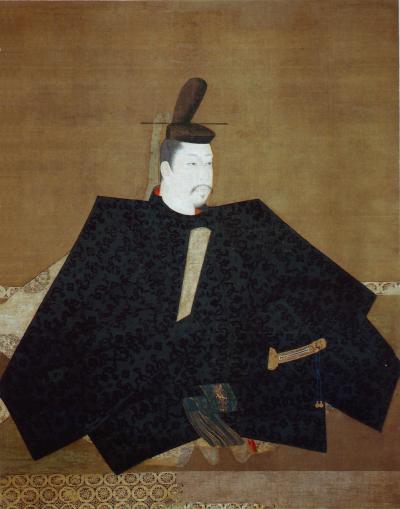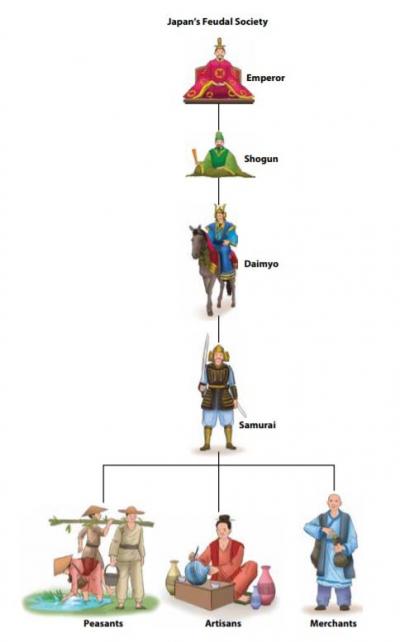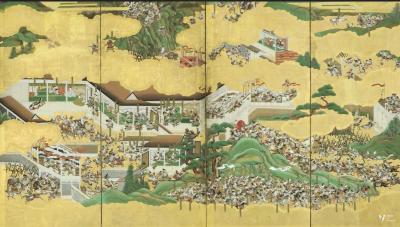Kamakura: The Home of the Samurai
Kamakura: The Home of the Samurai
This complete module with links to all materials may be downloaded as a PDF here.
Brian Smith
Jefferson Middle School
Oak Ridge, Tennessee

Portrait of Yoritomo Minamoto. Source: Wikipedia at https://tinyurl.com/ycgum84v.
This module is designed for a seventh-grade Tennessee world history and geography course. It is particularly applicable to Tennessee standard 7.11—“Analyze the rise of a military society in the late 12th century and the role of the shogun and samurai in Japanese society.”
The content and pedagogical activities in the module can be utilized in any middle school social studies class that includes history and geography content on medieval Japan.
Estimated module length: Two hours, fifty-five minutes, plus homework
Overview
By the beginning of the Kamakura period (1185–1333), Japan had established a military government controlled by the shogun and supported by the samurai class. The samurai were warriors whose education required them to “master the bow and the horse, as well as the brush and the word.” The creation of a military-controlled government located in Kamakura was both a geographic and cultural shift from the aristocratic rule and court life that were prevalent during the Heian period.
Objectives
Students will:
Analyze the rise of a military society during the Kamakura period.
Comprehend the role of the shogun and samurai during the Kamakura period.
Prerequisite knowledge
This lesson would take place after students learned prior information about East Asia, including introductory knowledge of China and its influence on Japan (written characters, Confucianism, and Buddhism) during the Heian period. Students should be able to identify and locate various locations and physical features related to Japan. Students should have already been taught the basic tenets of Shintoism. Students should also be familiar with traditional social hierarchy structures prevalent in the ancient and medieval worlds.
Module introduction
Class No. 1: Kamakura and the samurai
Estimated time: twenty-five minutes
Engage students with the following questions to assess their knowledge of samurai culture. The class can construct a know–want to learn–learned (KWL) chart. Use these questions to begin the module:
What do you know about the samurai?
How do you know it?
What are your sources?
Who created the source?
When was the source created?
Why was the source created?
How did you learn about it?
What questions do you have?
Japan’s changing social hierarchy: Provide a brief didactic overview describing changes in the Heian social structure. Make sure students know that while the emperor remained in the imperial capital of Kyoto, Yoritomo, the first shogun chose not to live in the imperial capital and ran the country from the seaside town of Kamakura. Use the graphic on Japan’s feudal society to help students have a better understanding of social structure in the age of the shogun

Japanâs feudal society: Note that unlike Chinese emperors, Japanese emperors reigned but did not have substantial political power. Source: The Core Knowledge Foundation. This work and activities are based on an original work of the Core Knowledge ® Foundation made available through licensing under a Creative Commons Attribution-Noncommercial- ShareAlike 4.0 International License. This does not in any way imply that the Core Knowledge Foundation endorses this work. (Citation Required per Usage Agreement)
Watch one or both of the following that pertain to Kamakuraâs geography and history:
âKamakura: Home of the Samurai Cultureâ from Web Japan (approximately five minutes) is a nice introduction to the history and contemporary life of the town where the first shogun established his headquarters.
This video, produced by NHK, Japanâs only public broadcasting network (approximately six minutes), also is a good, engaging overview of Kamakuraâs geography and cultural history; however, instructors might wish to show only the 0:34â3:40 time segment of the video because the talking heads interview format might not be engaging to students.
After students watch the videos, conduct a short class discussion focusing on the geography and culture of Kamakura. First, briefly review basic points about Japanâs geography. Then, discuss the following questions with students:
What made Kamakura a good choice for the shogunâs military government?
What were some interesting cultural or historic features about Kamakura?
Authorâs notes on studentsâ responses: Below are two examples of student responses after watching the videos and discussion
âI did not realize that samurai used bows and arrowsâ; âHorses! I didnât realize that Japan had horses.â
Students had the following observations about the physical and human geography of Kamakura:
âItâs cool to have a city where you did not have to build a wall; the mountains are like a natural fort; it is weird that there are no samurai monuments or war memorials . . . In most of Washington, D.C., there are war memorials.â
Class No. 2: Kamakura period Google Map
Estimated time: fifty minutes
Next, provide the link to a Kamakura period Google Map and handout of Kamakura Google Map questions. This map is based on the âKamakura Period of Japan Timeline,â provided by the city of Kamakura on their website. Here is the handout and the correct answers.
Authorâs notes on studentsâ reactions: Using the map appealed to some students more than reading about Kamakura.
Class No. 3: Using the samurai to teach critical thinking
Estimated time: fifty minutes
You may opt to have the class watch this video the night before as homework. This is from the Asian Art Museum and based on The Tale of the Heike (approximately eight minutes). The Tale of the Heike is a classic war epic that is often compared to Homerâs Iliad. The video is a succinct summation of the literary work based upon the Genpei War (1180â1185) between the Taira and Minamoto clans.

Source: Screen capture of the Asian Art Museum’s video on The Tale of the Heike at https://tinyurl.com/y9or75e5.
Instructors first should familiarize themselves with the Asian Art Museum of San Francisco’s lesson “Samurai Warrior Codes: Comparing Perspectives from the Kamakura, Muromachi, and Edo Periods,†which includes a lesson description, PowerPoint, and student handouts. Once students have learned more about the samurai, provide the museum’s handout for students.
If you feel that students will need more guidance on using artwork, I strongly suggest including “Battles at Ichi-no-tani Mountain and Yashima, from Tale of the Heike.†This separate three- page document features online art with short accompanying narratives and questions that richly augment the illustration on page 4 of "portraying the ideal warrior" in the abridged lesson below.
Class No. 4: Code of conduct for the samurai
Estimated time: fifty minutes
The Asian Art Museum and the University of California at Berkley have provided a “Samurai in Medieval Japan†lesson. I developed a modified abridged version of this lesson that only includes the primary source excerpts. Instructors might wish to examine the complete lesson. My handout directly addresses Tennessee standards, but it is probably useful for many instructors in other locales who do not have time to use the much longer lesson.
First, distribute the four-page document titled “HÅjÅ SÅun‘s Twenty-One Articles (Code of Conduct for Samurai)†to the class, also available here.
The first page of the handout provides brief biographical information on the samurai author HÅjÅ SÅun (1432–1519 CE). The next two short paragraphs on page 1 clearly define the two most critical components of the education of a samurai: bun encompasses literary arts and culture; bu æ¦ focuses upon warrior skills, especially skilled use of the sword.
Page 2 includes the same excerpts, along with an accompanying chart where, working with a partner, students are asked to paraphrase each excerpt and also note any questions or conclusions they have about the excerpt.
Page 3 is where students demonstrate what they know and have learned about the samurai.
Although student responses will vary, instructors will want to make sure students understand the most essential bun and bu behaviors samurai were expected to exhibit. Handout 3, which appears on page 4 of this document, is a teacher key with examples of correct student responses and conclusions.
Possible extension or homework (time determined by the teacher)
Instructors might prefer to have students create a “foldable†(or other) that demonstrates the changes in Japanese society and highlights life of a samurai. Make sure to address whether or not the samurai life as identified earlier matches the description provided in the text. Students should consider addressing the differences between the “real†and “imagined†life of a samurai.
Extension activities
For extension on the samurai, you should consider using “The Age of the Samurai: 1185–1868†(Asia for Educators). This annotated timeline describes the various characteristics of Kamakura, Ashikaga, and Tokugawa warrior governments.
The Tale of the Heike recounts the struggle for power between the Taira (or Heike) and Minamoto (or Genji) houses in the late twelfth century. With the Tairas’ defeat in 1185 and the establishment of a new warrior government by the victorious Minamoto, the medieval age began. From this war tale, we can learn much about life in Japan during this transitional period and about warrior culture. Use excerpted passages from the famous tale. Teachers should make copies of this to provide to students for reading and discussion (Asia for Educators).
References and resources
http://web-japan.org/jvt/en/streaming/mp4/jvt_12-13_no2_1_en_256k_mp4.html: This is a link to the “Kamakura—Home of Samurai Culture†video by Web Japan.
https://www.youtube.com/embed/NImB4S_Y3J0?rel=0: Here is a video on Kamakura by the NHK, posted on YouTube.
https://www.google.com/maps/d/viewer?mid=1zvTbcOq8bRriAOnPkWpgEXdBLPJAqyLb&ll=35.31905616126723%2C139.53592650000007&z=12: This is a link to the Google Map of the Kamakura period, which contains markers for various temples and other points of interest.
http://www.city.kamakura.kanagawa.jp/sekaiisan/documents/jh_booklet_e02.pdf: This booklet on the Kamakura period by the city of Kamakura is posted on their official website.
https://www.youtube.com/embed/YE1MwI69ooU?rel=0%22: This is a video on The Tale of the Heike by the Asian Art Museum on YouTube.
https://education.asianart.org/resources/samurai-warrior-codes-comparing-perspectives-from-the-kamakura-muromachi-and-edo-periods/: This is a middle school lesson on the Asian Art Museum’s “Education†website called “Samurai Warrior Codes: Comparing Perspectives from the Kamakura, Muromachi, and Edo Periods.â€
/sites/default/files/2020-12/medievaljapanlesson.pdf: This is a link to the student lesson “Medieval Japan, Samurai: Real and Imagined†on the Asian Art Museum’s “Education†website.
https://education.asianart.org/resources/tale-of-the-heike/: This is a link to artwork of the Battles at Ichi-no-tani Mountain and Yashima, from Tale of the Heike on the Asian Art Museum’s “Education†website.
http://ucbhssp.berkeley.edu/sites/default/files/hssplessons/Samurai in Medieval Japan_middle school.docx: Here is a link to a medieval Japan seventh-grade lesson plan from the Asian Art Museum and UC Berkeley’s “History–Social Science Project.â€
http://afe.easia.columbia.edu/special/japan_1000ce_samurai.htm: This is a link to the Asia for Educators “Guide to Samurai Governments, 1185–1868.â€
http://afe.easia.columbia.edu/special/japan_1000ce_heike.htm: This is a link to the Asia for Educators excerpts from The Tale of the Heike.
https://www.asianstudies.org/publications/eaa/archives/can-samurai-teach-critical-thinking-primary-sources-in-the-classroom/: This is a link to Ethan Segal, “Can Samurai Teach Critical Thinking?,†Education About Asia 15, no. 3 (2010): 5–8.
https://www.youtube.com/embed/h_rhvsV9Z7E?rel=0: This presentation is called “Using Samurai to Teach Critical Thinking†by Ethan Segal, from the University of Colorado program of the National Consortium for Teaching about Asia.
Bushido and the Samurai: http://www.japanpitt.pitt.edu/essays-and-articles/history/bushid%C5%8D-and-samurai: Martha Chaiklin’s “Bushido and the Samurai†from Japan: Places, Images, Times & Transformations by the University of Pittsburgh is available here.
https://learninglab.si.edu/collections/bushido-bun-and-bu-life-as-a-samurai/FFRP0MAp1BdoPjiL: Kate Harris’s “Bushido, Bun, and Bu: Life as a Samurai†on the Smithsonian Institute website is available here.
https://www.colorado.edu/ptea-curriculum/sites/default/files/attached-files/medieval-handout-m2.pdf: This is a link to the handout on samurai life in medieval Japan by the University of Colorado.
http://afe.easia.columbia.edu/tps/1000ce_jp.htm#kama: This link contains numerous resources on Japan from Asia for Educators.
http://education.asianart.org/explore-resources/samurai: This link contains numerous resources from the Asian Art Museum’s “Education†website.
https://www.coreknowledge.org/free-resource/ckhg-unit-08-feudal-japan/: For students with lower reading levels, check out the Core Knowledge resources on Japanese feudalism.